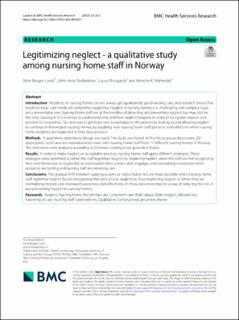| dc.contributor.author | Lund, Stine Borgen | |
| dc.contributor.author | Skolbekken, John-Arne | |
| dc.contributor.author | Mosqueda, Laura | |
| dc.contributor.author | Malmedal, Wenche Karin | |
| dc.date.accessioned | 2023-03-31T07:18:55Z | |
| dc.date.available | 2023-03-31T07:18:55Z | |
| dc.date.created | 2023-03-10T09:21:32Z | |
| dc.date.issued | 2023 | |
| dc.identifier.issn | 1472-6963 | |
| dc.identifier.uri | https://hdl.handle.net/11250/3061286 | |
| dc.description.abstract | Introduction
Residents in nursing homes do not always get qualitatively good nursing care, and research shows that residents’ basic care needs are sometimes neglected. Neglect in nursing homes is a challenging and complex issue, yet a preventable one. Nursing home staff are at the frontline of detecting and preventing neglect but may also be the ones causing it. It is essential to understand why and how neglect happens in order to recognize, expose, and prevent its occurrence. Our aim was to generate new knowledge on the processes leading to and allowing neglect to continue in Norwegian nursing homes, by studying how nursing home staff perceive and reflect on when nursing home residents are neglected in their daily practice.
Methods
A qualitative exploratory design was used. The study was based on five focus group discussions (20 participants, total) and ten individual interviews with nursing home staff from 17 different nursing homes in Norway. The interviews were analysed according to Charmaz constructivist grounded theory.
Results
In order to make neglect an acceptable practice, nursing home staff apply different strategies. These strategies were identified as when the staff legitimize neglect by neglecting neglect, when the staff are not recognizing their own behaviour as neglectful, as expressed in their actions and language, and normalizing missed care when resources are lacking and nursing staff are rationing care.
Conclusions
The gradual shift between judging actions as neglectful or not are made possible when nursing home staff legitimize neglect by not recognizing their practice as neglective, thus neglecting neglect or when they are normalizing missed care. Increased awareness and reflections on these processes may be a way of reducing the risk of and preventing neglect in nursing homes. | en_US |
| dc.language.iso | eng | en_US |
| dc.publisher | BioMed Central | en_US |
| dc.rights | Navngivelse 4.0 Internasjonal | * |
| dc.rights.uri | http://creativecommons.org/licenses/by/4.0/deed.no | * |
| dc.subject | Grounded Theory | en_US |
| dc.subject | Grounded Theory | en_US |
| dc.subject | Kvalitativ forskningsmetode | en_US |
| dc.subject | Qualitative research | en_US |
| dc.subject | Vold og overgrep blant eldre | en_US |
| dc.subject | Elder abuse | en_US |
| dc.subject | Forsømmelser i sykehjem | en_US |
| dc.subject | Neglect in nursing homes | en_US |
| dc.title | Legitimizing neglect - a qualitative study among nursing home staff in Norway | en_US |
| dc.title.alternative | Legitimizing neglect - a qualitative study among nursing home staff in Norway | en_US |
| dc.type | Peer reviewed | en_US |
| dc.type | Journal article | en_US |
| dc.description.version | publishedVersion | en_US |
| dc.source.volume | 23 | en_US |
| dc.source.journal | BMC Health Services Research | en_US |
| dc.source.issue | 212 | en_US |
| dc.identifier.doi | 10.1186/s12913-023-09185-1 | |
| dc.identifier.cristin | 2132932 | |
| cristin.ispublished | true | |
| cristin.fulltext | original | |
| cristin.qualitycode | 2 | |

